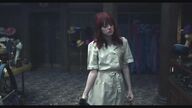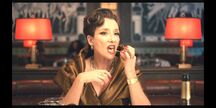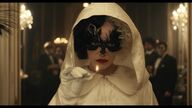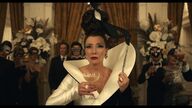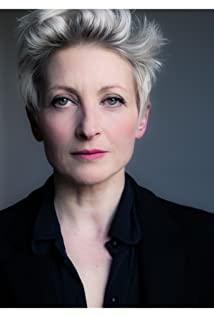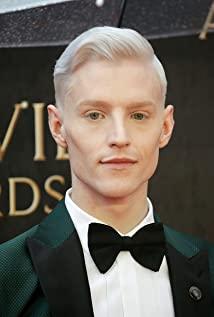"Black and White Witch Kuira", I learned from the advertisements before watching other movies, a woman with black and white hair who flashed by stood at a high place, her eyes were cold, and she looked down. I didn't know until I watched the feature film, that expression was the desire to invite Jun into the urn.
The background of the story is set in London in the 1870s. Britain, which was affected by World War II, developed rapidly with the support of the United States. The flourishing of fashion and punk, rebellion and freedom, has been seen in the lens of little Kuila sneaking into the show, full of intricate and avant-garde gorgeous dresses.
At the beginning of the film, the heroine, who is also called Estella, showed a different side-not only her black and white hair, but also the words "unrestrained" written on her face. character on. She fought back against her classmates who bullied her, dismissed her mother's normal sweater, and felt no guilt about being expelled from school. A naughty and troublesome child is destined to cause disaster.
The mother was killed by her, at least the first half of the heroine and the audience thought so. Estella is an orphan. She and the two little friends she meets by chance make a living by stealing, but they are also tenacious and tenacious.
As an adult, Estella showed amazing design talents. She was much simpler than others' underappreciated talents. An accidental modification of the window like venting her anger was recognized by the ceiling figure in the fashion industry at that time, the Baroness. The good wind went straight, and the outgoing designs one after another made the baroness green eyes, and said to her: "There is something."
If the story develops like this, it is at most a replica of "The Devil Wears Prada", which is insignificant. But when the camera turned, the kind and peaceful Estella saw her mother's relic - a ruby necklace at the baroness's place. Out of guilt and nostalgia, she released "Kuila", which had been hidden for more than ten years.
At the party, Kuira's iconic black and white hair was hidden in a cloak that reached the ground, and the familiar face was hidden under the mask. The flames burned lightly, revealing a delicate red dress, shining in the black and white banquet.
This fire burned out the appearance of "Estella", made her break with the past completely, and became "Kuila" elegantly and flamboyantly.
After failing to steal the gem, it was discovered that the baroness was the real murderer of her mother, and the heroine embarked on the road of revenge.
Since then, the evil and conceited smile on Kuira's lips opened the prelude to the climax of the plot.
Kuira - Arrogant, chaotic, cold, crazy.
She is synonymous with fashion, a fanatic of freedom, and a formidable enemy of the baroness. Kuila used his talent to stage a lively catwalk for the public. She can ride out on a motorcycle, disrupting the serenity and elegance of the conference; she can roll off a garbage truck, drag a newspaper skirt and whizz away; or she can step on the baroness's car roof, dressed in Punk military tops and fiery red petal skirts stand out from the crowd.
The baroness was defeated again and again, and the anger and humiliation of being pulled from the altar forced her to start fighting back. Facing the upcoming fashion show, she snatched the design of "Estella" who was still in ambush, but Kuila replaced all the metal decorations on the dress with cicadas. She was driven out of the venue by thousands of moths and came to her carefully prepared runway.
Lighting, music, dancing, wild and extremely frantic, like the claws and claws of human nature after repression. Her Dalmatian-colored skirt became the last straw for the baroness's collapse. The baroness's career, fame, power, and even her pet had all become Kuila's possessions. So killing the other party became the baroness's last choice.
This is the second fire in the movie. The cold and arrogant "Kuila" died. Kuila, who was rescued by the baroness's housekeeper, learned that he was the child of the baroness's attempted murder. The chaotic reality made her once It collapsed, but in the collapse, she clearly realized that her adoptive mother was working hard, day and night, to take care of her growth with love.
At the end of the story, Kuira, the protagonist, wins. She had the baroness push herself off a cliff in full view and send her to prison. Like the law of causality, Kuira calmly and triumphantly accepted the ending.
Maybe her blood is the same as that of the Baroness, they are born villains, but the existence of the adoptive mother is enough to pull Kuila back from the brink of becoming a demon, she will live as a bad person, and then leave a heart for others a little residual warmth.
In general, the film "Black and White Witch Kuira" does not jump out of the protagonist, that is, justice. It sets up a more stereotyped villain, the baroness, to rationalize all of Kuira's rebellious behavior and character flaws. . In comparison, Kuira's bad will not be so pure.
I don't know since when, female executives, female elites, female doctors, etc., who have the right to speak to a certain extent, will be portrayed as impersonal, indifferent, and mean. This facialized design can be seen in domestic and foreign film and television dramas. As a masked female villain, the baroness in "Kuila" inevitably reflects the stereotype of the above-mentioned people in the patriarchal society. The baroness chose to kill her child when she was pregnant because she was afraid of affecting her career. Although it was an insignificant picture, it briefly cut through the mask that women in society can have both family and career.
It is a pity that Kuila, a rebellious and crazy female image, finally turned into an emotional card, and became a Disney "good girl" in a rebellious coat. Her family with two friends, her three Dalmatians as pets, and her father's legacy as the new owner of the castle, all transformed Kuira into a rock-punk-esque "princess," "with the world for The enemy" has now become the slogan of the mouth.
Therefore, the film is not so much a book and biography for the villain as it is Disney's challenge to "rules" and failure, and a different kind of continuation of fairy tales.
View more about Cruella reviews



